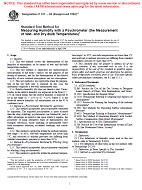1.1 General:
1.1.1 This test method covers the determination of the humidity of atmospheric air by means of wet- and dry-bulb temperature readings.
1.1.2 This test method is applicable for meteorological measurements at the earth’s surface, for the purpose of the testing of materials, and for the determination of the relative humidity of most standard atmospheres and test atmospheres.
1.1.3 This test method is also applicable when the temperature of the wet bulb only is required. In this case, the instrument comprises a wet-bulb thermometer only.
1.1.4 Relative humidity (rh) does not denote a unit. Uncertainties in the relative humidity are expressed in the form U + u % rh, which means that the relative humidity is expected to lie in the range ( U – )% to ( U + )%, where U is the observed relative humidity. All uncertainties are at the 95% confidence level.
1.2 Method A – Psychrometer Ventilated by Aspiration:
1.2.1 This method incorporates the psychrometer ventilated by aspiration. The aspirated psychrometer is more accurate than the sling (whirling) psychrometer (see Method B), and it offers advantages in regard to the space which it requires, the possibility of using alternative types of thermometers (for example, electrical), easier shielding of thermometer bulbs from extraneous radiation, accidental breakage, and convenience.
1.2.2 This method is applicable within the ambient temperature range 5 to 80°C, wet-bulb temperatures not lower than 1°C, and restricted to ambient pressures not differing from standard atmospheric pressure by more than 30%.
1.3 Method B – Psychrometer Ventilated by Whirling (Sling Psychrometer):
1.3.1 This method incorporates the psychrometer ventilated by whirling (sling psychrometer).
1.3.2 This method is applicable within the ambient temperature range 5 to 50°C, wet-bulb temperatures not lower than 1°C and restricted to ambient pressures not differing from standard atmospheric pressure by more than 30%.
1.4 This standard does not purport to address all of the safety concerns, if any, associated with its use. It is the responsibility of the user of this standard to establish appropriate safety and health practices and determine the applicability of regulatory limitations prior to use. (For more specific safety precautionary statements, see 8.1 and 15.1.)
Product Details
- Published:
- 01/01/1996
- Number of Pages:
- 23
- File Size:
- 1 file , 160 KB
